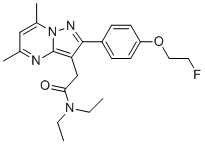
| 规格 | 价格 | 库存 | 数量 |
|---|---|---|---|
| 1mg |
|
||
| 5mg |
|
||
| 10mg |
|
||
| Other Sizes |
|
| 体内研究 (In Vivo) |
由于 APPswe×PS1Δe9 小鼠中的 AD 样病理学和年龄,[ 18 F]DPA-714 结合在体内显着升高。
|
|---|---|
| 参考文献 |
[1]. James ML, et al. DPA-714, a new translocator protein-specific ligand: synthesis, radiofluorination, and pharmacologic characterization. J Nucl Med. 2008 May;49(5):814-22.
[2]. Harhausen D, et al. Specific imaging of inflammation with the 18 kDa translocator protein ligand DPA-714 in animal models of epilepsy and stroke. PLoS One. 2013 Aug 2;8(8):e69529. |
| 分子式 |
C22H27FN4O2
|
|---|---|
| 分子量 |
398.48
|
| 精确质量 |
398.211
|
| CAS号 |
958233-07-3
|
| PubChem CID |
24895172
|
| 外观&性状 |
White to off-white solid powder
|
| 密度 |
1.2±0.1 g/cm3
|
| 折射率 |
1.581
|
| LogP |
2.86
|
| tPSA |
59.7
|
| 氢键供体(HBD)数目 |
0
|
| 氢键受体(HBA)数目 |
5
|
| 可旋转键数目(RBC) |
8
|
| 重原子数目 |
29
|
| 分子复杂度/Complexity |
525
|
| 定义原子立体中心数目 |
0
|
| SMILES |
O=C(CC1=C2N=C(C)C=C(N2N=C1C1C=CC(OCCF)=CC=1)C)N(CC)CC
|
| InChi Key |
FLZZFWBNYJNHMY-UHFFFAOYSA-N
|
| InChi Code |
InChI=1S/C22H27FN4O2/c1-5-26(6-2)20(28)14-19-21(17-7-9-18(10-8-17)29-12-11-23)25-27-16(4)13-15(3)24-22(19)27/h7-10,13H,5-6,11-12,14H2,1-4H3
|
| 化学名 |
N,N-diethyl-2-(2-(4-(2-fluoroethoxy)phenyl)-5,7-dimethylpyrazolo[1,5-a]pyrimidin-3-yl)acetamide
|
| 别名 |
DPA714DPA-714 DPA 714J2.865.885K
|
| HS Tariff Code |
2934.99.9001
|
| 存储方式 |
Powder -20°C 3 years 4°C 2 years In solvent -80°C 6 months -20°C 1 month |
| 运输条件 |
Room temperature (This product is stable at ambient temperature for a few days during ordinary shipping and time spent in Customs)
|
| 溶解度 (体外实验) |
DMSO : ~41.67 mg/mL (~104.57 mM)
|
|---|---|
| 溶解度 (体内实验) |
配方 1 中的溶解度: ≥ 2.08 mg/mL (5.22 mM) (饱和度未知) in 10% DMSO + 40% PEG300 + 5% Tween80 + 45% Saline (这些助溶剂从左到右依次添加,逐一添加), 澄清溶液。
例如,若需制备1 mL的工作液,可将100 μL 20.8 mg/mL澄清DMSO储备液加入400 μL PEG300中,混匀;然后向上述溶液中加入50 μL Tween-80,混匀;加入450 μL生理盐水定容至1 mL。 *生理盐水的制备:将 0.9 g 氯化钠溶解在 100 mL ddH₂O中,得到澄清溶液。 配方 2 中的溶解度: ≥ 2.08 mg/mL (5.22 mM) (饱和度未知) in 10% DMSO + 90% Corn Oil (这些助溶剂从左到右依次添加,逐一添加), 澄清溶液。 例如,若需制备1 mL的工作液,可将 100 μL 20.8 mg/mL 澄清 DMSO 储备液加入到 900 μL 玉米油中并混合均匀。 请根据您的实验动物和给药方式选择适当的溶解配方/方案: 1、请先配制澄清的储备液(如:用DMSO配置50 或 100 mg/mL母液(储备液)); 2、取适量母液,按从左到右的顺序依次添加助溶剂,澄清后再加入下一助溶剂。以 下列配方为例说明 (注意此配方只用于说明,并不一定代表此产品 的实际溶解配方): 10% DMSO → 40% PEG300 → 5% Tween-80 → 45% ddH2O (或 saline); 假设最终工作液的体积为 1 mL, 浓度为5 mg/mL: 取 100 μL 50 mg/mL 的澄清 DMSO 储备液加到 400 μL PEG300 中,混合均匀/澄清;向上述体系中加入50 μL Tween-80,混合均匀/澄清;然后继续加入450 μL ddH2O (或 saline)定容至 1 mL; 3、溶剂前显示的百分比是指该溶剂在最终溶液/工作液中的体积所占比例; 4、 如产品在配制过程中出现沉淀/析出,可通过加热(≤50℃)或超声的方式助溶; 5、为保证最佳实验结果,工作液请现配现用! 6、如不确定怎么将母液配置成体内动物实验的工作液,请查看说明书或联系我们; 7、 以上所有助溶剂都可在 Invivochem.cn网站购买。 |
| 制备储备液 | 1 mg | 5 mg | 10 mg | |
| 1 mM | 2.5095 mL | 12.5477 mL | 25.0954 mL | |
| 5 mM | 0.5019 mL | 2.5095 mL | 5.0191 mL | |
| 10 mM | 0.2510 mL | 1.2548 mL | 2.5095 mL |
1、根据实验需要选择合适的溶剂配制储备液 (母液):对于大多数产品,InvivoChem推荐用DMSO配置母液 (比如:5、10、20mM或者10、20、50 mg/mL浓度),个别水溶性高的产品可直接溶于水。产品在DMSO 、水或其他溶剂中的具体溶解度详见上”溶解度 (体外)”部分;
2、如果您找不到您想要的溶解度信息,或者很难将产品溶解在溶液中,请联系我们;
3、建议使用下列计算器进行相关计算(摩尔浓度计算器、稀释计算器、分子量计算器、重组计算器等);
4、母液配好之后,将其分装到常规用量,并储存在-20°C或-80°C,尽量减少反复冻融循环。
计算结果:
工作液浓度: mg/mL;
DMSO母液配制方法: mg 药物溶于 μL DMSO溶液(母液浓度 mg/mL)。如该浓度超过该批次药物DMSO溶解度,请首先与我们联系。
体内配方配制方法:取 μL DMSO母液,加入 μL PEG300,混匀澄清后加入μL Tween 80,混匀澄清后加入 μL ddH2O,混匀澄清。
(1) 请确保溶液澄清之后,再加入下一种溶剂 (助溶剂) 。可利用涡旋、超声或水浴加热等方法助溶;
(2) 一定要按顺序加入溶剂 (助溶剂) 。
| NCT Number | Recruitment | interventions | Conditions | Sponsor/Collaborators | Start Date | Phases |
| NCT06289582 | NOT YET RECRUITING | Drug: [F-18]DPA714 administration IV | Parkinson Disease | University of Alabama at Birmingham | 2024-06 | Early Phase 1 |
| NCT05672082 | WITHDRAWN | Drug: [18F]DPA-714 | Glioma | Center Eugene Marquis | 2023-10-01 | Not Applicable |
| NCT03759522 | RECRUITING | Drug: DPA-714 PET/MRI | Chronic Fatigue Syndrome Fibromyalgia Healthy Multiple Sclerosis |
University of Alabama at Birmingham | 2019-02-03 | Phase 1 |
| NCT04320030 | COMPLETED | Drug: [18F]-DPA-714 PET/CT scan | Triple Negative Breast Cancer | Institut Cancerologie de l'Ouest | 2020-06-11 | Phase 2 |
| NCT03457493 | RECRUITING | Drug: DPA-714-PET/MRI Drug: 5-year Follow-up DPA-714-PET/MRI Drug: DPA-714 Metabolite Analysis |
Parkinson Disease | University of Alabama at Birmingham | 2018-03-22 | Phase 1 Phase 2 |
|
|
|